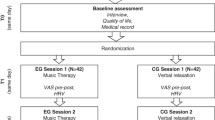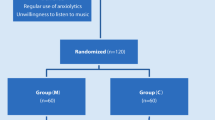Abstract
Objectives
The ALMUT study wants to evaluate the anxiolytic effects of different music styles and no music in 200 patients undergoing cardiac catheterization and to assess if there is a difference if patients select one of these therapies or are randomized to one of them.
Background
The anxiolytic and analgesic effects of music have been described in previous trials. Some authors have suggested to evaluate whether patient-selected music is more effective than the music selected by the physician in reducing anxiety and stress levels.
Methods and results
After randomization 100 patients (group A) were allowed to choose between classical music, relaxing modern music, smooth jazz, and no music. One hundred patients (group B) were randomized directly to one of these therapies (n = 25 each). Complete data were available for 197 patients (65 ± 10 years; 134 male). Using the State-Trait Anxiety Inventory (STAI) all patients in group B who listened to music showed a significantly higher decrease of their anxiety level (STAI-State difference pre-post of 16.8 ± 10.2) compared to group A (13.3 ± 11.1; p = 0.0176). Patients without music (6.2 ± 6.7) had a significantly weaker reduction of anxiety compared to all music-listeners (14.9 ± 10.7, p < 0.0001).
Conclusions
The positive effects of music in the cath lab support previous reports. Surprisingly, the hypothesis that the patient’s choice of preferred music might yield higher benefits than a randomized assignment could be dismissed.





Similar content being viewed by others
References
Blood DJ, Ferriss SJ (1993) Effects of background music on anxiety, satisfaction with communication, and productivity. Psychol Rep 72:171–177
Buffum MD, Sasso C, Sands LP, Lanier E, Yellen M, Hayes A (2006) A music intervention to reduce anxiety before vascular angiography procedures. J Vasc Nurs 24:68–73
Byers JF, Smyth KA (1997) Effect of a music intervention on noise annoyance, heart rate, and blood pressure on cardiac surgery patients. Am J Crit Care 6:183–191
Chan MF, Wong OC, Chan HL, Fong MC, Lai SY, Lo CW, Ng SY, Leung SK (2006) Effects of music on patients undergoing a C-clamp procedure after percutaneous coronary interventions. J Adv Nurs 53:669–679
Evans D (2002) The effectiveness of music as an intervention for hospital patients: a systematic review. J Adv Nurs 37:8–13
Hamel WJ (2001) The effects of music intervention on anxiety in the patient waiting for cardiac catheterization. Intensive Crit Care Nurs 17:279–285
Lee HR (2003) Effects of relaxing music on stress response of patients with acute myocardial infarction. Taehan Kanho Hakhoe Chi 33:693–704
Marconato C, Munhoz EC, Menim MM, Albach MT (2001) Application of receptive music therapy in internal medicine and cardiology. Arq Bras Cardiol 77:140–141
Mok E, Wong KY (2003) Effects of music on patient anxiety. AORN J 77:396–410
Nilsson U (2008) The anxiety-and pain-reducing effects of music interventions: a systematic review. AORN J 87:780–807
Rudin D, Kiss A, Wetz RV, Sottile VM (2007) Music in the endoscopy suite: a meta-analysis of randomized controlled studies. Endoscopy 39:507–510
Sendelbach SE, Halm MA, Doran KA, Miller EH, Gaillard P (2006) Effects of music therapy on physiological and psychological outcomes for patients undergoing cardiac surgery. J Cardiovasc Nurs 21:194–200
Spintge R (2000) Musik in Anästhesie und Schmerztherapie. Anästhesiol Intensivmed Notfallmed Schmerzther 35:254–265
Strauser J (1997) The effect of music versus silence of measures of state anxiety, perceived relaxation, and physiological responses. J Music Ther 26:168–187
Twiss E, Seaver J, McCaffrey R (2006) The effects of music listening on older adults undergoing cardiovascular surgery. Nurs Crit Care 11:224–231
Vollert JO, Störk T, Rose M, Möckel M (2003) Music as adjuvant therapy for coronary heart disease. therapeutic music lowers anxiety, stress and beta-endorphin concentrations in patients from a coronary sport group. Dtsch Med Wochenschr 128:2712–2716
White JM (2000) State of the science of music interventions. Critical care and perioperative practice. Crit Care Nurs Clin North Am 12:219–225
Winter MJ, Paskin S, Baker T (1994) Music reduces stress and anxiety of patients in the surgical holding area. J Post Anesth Nurs 9:340–343
Hillecke T, Nickel A, Bolay HV (2005) Scientific perspectives on music therapy. Ann N Y Acad Sci 1060:271–282
Siedliecki SL, Good M (2006) Effect of music on power, pain, depression and disability. J Adv Nurs 54:553–562
Hamm CW, Albrecht A, Bonzel T, Kelm M, Lange H, Schächinger V, Terres W, Voelker W (2008) Diagnostik heart catherization. Clin Res Cardiol 97:475–512
Bonzel T, Erbel R, Hamm CW, Levenson B, Neumann FJ, Rupprecht HJ, Zahn R (2008) Percutaneous coronary interventions (PCI). Clin Res Cardiol 97:513–547
Werner GS, Gitt AK, Zeymer U, Juenger C, Towae F, Wienbergen H, Senges J (2009) Chronic total coronary occlusion in patients with stable angina pectoris: impact on therapy and outcome in present day clinical practice. Clin Res Cardiol 98:435–441
Laux L, Glanzmann P, Schaffner P, Spielberger CD (1981) Das State-Trait-Angstinventar. Beltz, Göttingen
Bernardi L, Porta C, Sleight P (2006) Cardiovascular, cerebrovascular and respiratory changes induced by different types of music in musicians and non-musicians: the importance of silence. Heart 92:445–452
Gosselin N, Peretz I, Johnsen E, Adolphs R (2007) Amygdala damage impairs emotion recognition from music. Neuropsychol 45:236–244
Mitterschiffthaler MT, Fu Ch, Dalton JA, Andrew CM, Williams SC (2007) A functional MRI study of happy and sad affective states induced by classical music. Hum Brain Mapp 28:1150–1162
Knight WE, Rickard NS (2001) Relaxing music prevents stress-induced increases in subjective anxiety, systolic blood pressure, and heart rate in healthy males and femals. J Music Ther 38:254–272
Stefano GB, Zhu W, Cadet P, Salamon E, Mantione KJ (2004) Music alters constitutively expressed opiate and cytokine processes in listeners. Med Sci Monit 10:18–27
Argstatter H, Haberbosch W, Bolay HV (2006) Study of the effectiveness of musical stimulation during intracardiac catheterization. Clin Res Cardiol 95:514–522
Spitzer M (2006) Musik im Kopf. Hören, Musizieren, Verstehen und Erleben im neuronalen Netzwerk. Schattauer, Stuttgart, p 431
Bally K, Campbell D, Chesnick K, Tranmer JE (2003) Effects of patient-controlled music therapy during coronary angiography on procedural pain and anxiety distress syndrome. Crit Care Nurse 23:50–58
Altenmüller E, Kopiez R (2005) Schauer und Tränen: zur Neurobiologie der durch Musik ausgelösten Emotionen. In: Bullerjahn C, Gembris H, Lehmann AC (eds) Musik: gehört, gesehen und erlebt. Festschrift Klaus-Ernst Behne zum 65. Geburtstag. Verlag der Hochschule für Musik und Theater, Hannover, pp 159–179
De la Motte-Haber H (1975) Musikpsychologie. In: Dahlhaus C (ed) Einführung in die systematische Musikwissenschaft, 2nd edn. Gerig, Köln, pp 53–93
Sacks O (2008) Der einarmige Pianist. Über Musik und das Gehirn. Rowohlt, Reinbek, p 376
Jourdain R (2001) Das wohltemperierte Gehirn. Wie Musik im Kopf entsteht und wirkt, 2nd edn. Spektrum, Akademischer Verlag, Heidelberg, p 375
Salamon E, Bernstein SR, Kim SA, Kim M, Stefano GB (2003) The effects of auditory perception and musical preference on anxiety in naive human subjects. Med Sci Monit 9:396–399
Khalfa S, Bella SD, Roy M, Peretz I, Lupien SJ (2003) Effects of relaxing music on salivary cortisol level after psychological stress. Ann N Y Acad Sci 999:374–376
Heikkilä J, Paunonen M, Virtanen V, Laippala P (1998) Fears of patients related to coronary arteriography. J Adv Nurs 28:52–62
Peterson M (1991) Patient anxiety before cardiac catherization: an intervention study. Heart Lung 20:643–647
Acknowledgments
The ALMUT study was supported by the Anton Betz Stiftung e.V. of the Rheinische Post, Düsseldorf,to W.G.
Conflict of interest
None declared.
Author information
Authors and Affiliations
Corresponding author
Rights and permissions
About this article
Cite this article
Goertz, W., Dominick, K., Heussen, N. et al. Music in the cath lab: who should select it?. Clin Res Cardiol 100, 395–402 (2011). https://doi.org/10.1007/s00392-010-0256-1
Received:
Accepted:
Published:
Issue Date:
DOI: https://doi.org/10.1007/s00392-010-0256-1




